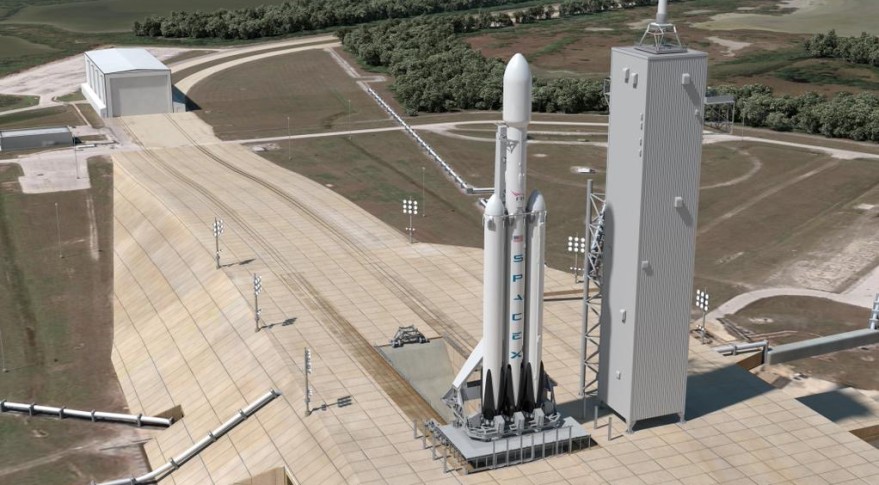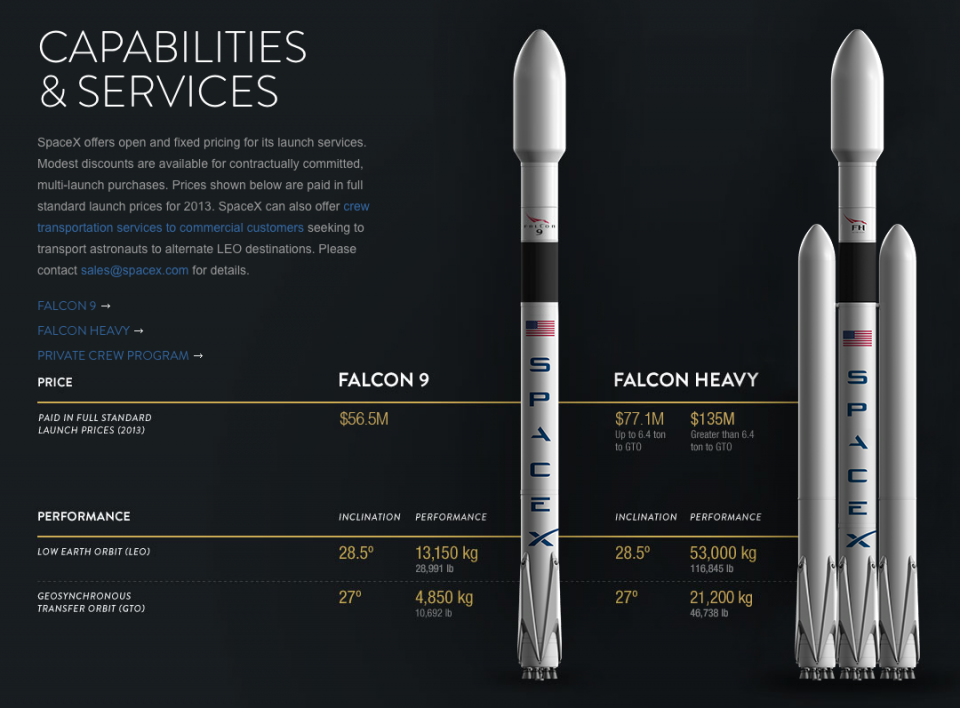SpaceX needs two additional platforms for the simultaneous landing of three return stages

The other day, the company Ilona Mask SpaceX successfully carried out another launch of the Falcon 9 rocket and planted the return first stage on the land without any problems . This is the second landing stage in the company's history on solid ground, and not on an offshore platform. Apparently, the SpaceX landing process is more or less debugged. And now the leadership sets a new goal: to plant three returnable steps almost simultaneously.
The need to plant three stages at once at one time is due to the fact that the first test of the heavy Falcon Heavy launch vehicle is scheduled for this year. The new SpaceX rocket is a Falcon 9 with two accelerators set on its sides, made on the basis of the first stage of the Falcon 9 FT. The launch is scheduled from the launch site LC-39A (Florida, USA). If there are no unforeseen problems, the rocket will fly in November of this year. Two stages of side accelerators should return almost simultaneously, to one place, within one minute. The stage of the central part of the rocket is also planned to be returned. It can try to put on an automatic offshore platform, if the fuel is not enough to return to the landing area on land.
')
In order to launch, the company must carefully prepare the entire system of the LC-39 complex. It also launched the Saturn V rocket, which sent the Apollo 11 to the moon. Since then, the power site almost never used. On April 14, 2014, a lease was signed between NASA and SpaceX, with which the launch pad LC-39A is transferred to SpaceX's exclusive use for 20 years.

At the top of Falcon Heavy accelerators there is a composite protective cone. Each accelerator has 9 Merlin 1D liquid-propellant rocket engines arranged according to the Octaweb scheme, with one central engine and the other eight located around it. In total, when launching, 27 Merlin 1D engines (central unit and side accelerators) create thrust of 22,819 kN at sea level and 24,681 kN in vacuum.
Due to the fact that the first stage of the Falcon Heavy, when disconnecting from the second stage, will have a much higher speed and will be much farther from the launch pad, compared to the first stage of the Falcon 9, the need to return it to the landing platform will significantly reduce the mass of the output load. Therefore, in high-energy missions to a geo-transfer orbit, it will land on a floating platform. Side accelerators, on the contrary, will be able to return to the launch site and land on the ground in the vast majority of launch scenarios, as mentioned above.
“We are striving to obtain regulatory approval for the creation of two additional landing sites at the US Air Force base at Cape Canaveral. We hope to return all three Falcon Heavy rockets, although initially we can try to land on the offshore platform, ”a company spokesman said. Now the company has two lease agreements for the conversion of two sites.
- US Air Force Base at Cape Canaveral - Landing Zone 1 (formerly the LC-13 launch complex); rented from the USAF.
- Base Vandenberg - starting complex SLC-4W; rented from the USAF.
SpaceX seeks to return all three Falcon 9 stages to reduce the cost of launching this massive rocket. Since 2014, the company's website indicated the launch cost of Falcon Heavy with a payload of up to 6.4 tons per GPO (geo-transfer orbit) at $ 85 million. In 2015, the cost was increased to $ 90 million.
Table of calculation of the cost of one-time and reusable spaceX rockets ( source )
| Indicator | Falcon 9 | Falcon heavy |
|---|---|---|
| Starting cost | $ 61.2 million | $ 90.0 million |
| Estimated total markup | 40% | |
| Cost price | $ 36.7 million | $ 54.0 million |
| The share of the first stage in the cost of the rocket | 75% | |
| The cost of the first stage | $ 27.5 million | $ 40.5 million |
| Other costs | $ 9.2 million | $ 13.5 million |
| Resource (number of flights) | 15 | |
| Estimated first-flight cost per flight | $ 1.8 million | $ 2.7 million |
| Estimated cost of one flight of reusable PH | $ 11.0 million | $ 16.2 million |
| Cost reduction | $ 25.7 million | $ 37.8 million |
| The share of savings going to reduce the final price | 50% | |
| Estimated Starting Cost | $ 48.3 million | $ 71.1 million |
| Savings compared to a disposable rocket | 21% | |
| One-time missile added value | 40% | |
| Added value reusable rocket | 77% | |
| Profit before deduction from a disposable rocket | $ 24.5 million | $ 36.0 million |
| Profit before deduction from reusable rocket | $ 37.3 million | $ 54.9 million |
Can't wait for all three cores of the Falcon Heavy to come back for landings! First two will be almost simultaneous. https://t.co/ryMiewZM4L
- Elon Musk (@elonmusk) July 18, 2016
Wherever SpaceX decides to plant the return stages, the launch of a heavy launch vehicle is another important step in the work of this company. It is this rocket Ilon Musk sees as a tool for sending equipment for colonists to Mars or the Moon.
Really, it’s a bit of a reversal (for Falcon Heavy has enough power)
- Elon Musk (@elonmusk) July 18, 2016
Source: https://habr.com/ru/post/396255/
All Articles